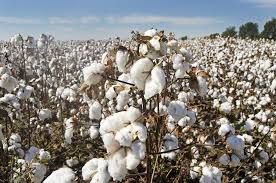Which of the following states produces the most cotton in a single year?
A) Arkansas
B) Mississippi
C) Texas
D) Georgia
Among the US states, Texas is the largest producer of cotton, contributing about 40% of the US production each year. So…When in doubt, always choose “C” as your multiple-choice answer!
Cotton grows in Texas! We had no idea! We know what corn and soybean fields look like because of where we are from. We learned in Minnesota what sugar beet fields look like and now we have an idea of what harvested cotton fields look like. One day we hope to see a cotton field before harvest. When we arrived in Texas at the end of November the cotton harvest was almost complete. Driving along the country roads would see bales, or large rolls of cotton, wrapped in colorful plastic, and some fields had huge “loafs” of cotton. We have learned that these are called cotton modules.
There happen to be several cotton gins (mills) in the area, and one in Silverton, TX, the town we are currently living in. It took us a while to figure out what the fan or engine noise we heard on some days when we were out walking. The owner where we are working has a friend who knows …. And we were able to get a tour of the cotton gin! If you never ask, you’ll never get it, right? The answer might be, “no,” but at least you asked! We asked and we were treated to an amazing tour! We even got samples of some of the beginning and end products!
The mill in Silverton hires mostly transient workers. We found out that most of these workers come up from the Dallas area (about 5.5-hour drive) and are construction workers taking a seasonal break from construction to help with the cotton gin. The day of our tour was the final milling day for this particular company.
The harvesting process picks the cotton boll from the plant and rolls them into a bale or packs them into a “loaf.” These modules are transported to the mill where the ginning happens. The ginning process separates the cotton fibers from the seeds, stems, leaves and dirt.
Check out the photos for more details.
We RVery Blessed

Silverton, Texas is located in the Texas panhandle between Amarillo and Lubbock.

Many of the cotton gins in Texas were family-owned, like this one. But, most have been bought out by large conglomerates.

Here you can see the truck about to off-load a module at the beginning of the ginning process.

This is a pic of a cotton “module” that has been unloaded from a special truck. The truck would have literally picked up the module from a nearby farmer and delivered it to the gin. The module is about 32′ long and weighs between 15-20k pounds.

This module is number 1425 for this gin to process. They also process smaller rectangular bales and large round bales.

This sign is in the Gin Managers office.

The entire gin operates on air movement of the cotton.

This is a row of “de-seeders”.

This is a “dryer”.

This is a pic of several modules sitting in the field, waiting to be brought to the gin for processing.

The cleaned cotton is forced into bales and wrapped by this machine.

This is a giant storage facility for the seeds that have been pulled from the cotton in the ginning process. These seeds are nearly as valuable as the cleaned cotton is. These seeds are sold to farmers to feed to their cattle and for processing to extract cotton seed oil. The seeds are high in protein.

There is an oil in cotton so it will resist some water. The farmers cover the modules in the fields to keep the cotton from blowing away in the panhandles 45mph breezes!

We drove into a local field and snapped this pic of Ken in front of one of the many modules.

This is the final product of the cotton gin. Here you see five bales. These bales of cleaned cotton weigh about 500 lbs each. Their next destination is somewhere like Taiwan or Indonesia to be made into cloth for clothing.







